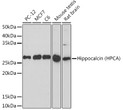| Host: | Rabbit |
| Applications: | WB/ELISA |
| Reactivity: | Human/Mouse/Rat |
| Note: | STRICTLY FOR FURTHER SCIENTIFIC RESEARCH USE ONLY (RUO). MUST NOT TO BE USED IN DIAGNOSTIC OR THERAPEUTIC APPLICATIONS. |
| Clonality : | Monoclonal |
| Clone ID : | S4MR |
| Conjugation: | Unconjugated |
| Isotype: | IgG |
| Formulation: | PBS with 0.02% Sodium Azide, 0.05% BSA, 50% Glycerol, pH 7.3. |
| Purification: | Affinity purification |
| Concentration: | Lot specific |
| Dilution Range: | WB:1:500-1:2000ELISA:Recommended starting concentration is 1 Mu g/mL. Please optimize the concentration based on your specific assay requirements. |
| Storage Instruction: | Store at-20°C for up to 1 year from the date of receipt, and avoid repeat freeze-thaw cycles. |
| Gene Symbol: | HPCA |
| Gene ID: | 3208 |
| Uniprot ID: | HPCA_HUMAN |
| Immunogen Region: | 1-100 |
| Specificity: | A synthetic peptide corresponding to a sequence within amino acids 1-100 of human Hippocalcin (HPCA) (P84074). |
| Immunogen Sequence: | MGKQNSKLRPEMLQDLRENT EFSELELQEWYKGFLKDCPT GILNVDEFKKIYANFFPYGD ASKFAEHVFRTFDTNSDGTI DFREFIIALSVTSRGRLEQK |
| Tissue Specificity | Brain specific. |
| Post Translational Modifications | Myristoylation facilitates association with membranes. |
| Function | Calcium-binding protein that may play a role in the regulation of voltage-dependent calcium channels. May also play a role in cyclic-nucleotide-mediated signaling through the regulation of adenylate and guanylate cyclases. |
| Protein Name | Neuron-Specific Calcium-Binding Protein HippocalcinCalcium-Binding Protein Bdr-2 |
| Cellular Localisation | CytoplasmCytosolMembranePeripheral Membrane ProteinAssociation With Membranes Is Calcium-DependentEnriched In The Perinuclear RegionProbably At The Trans Golgi Network In Response To Calcium |
| Alternative Antibody Names | Anti-Neuron-Specific Calcium-Binding Protein Hippocalcin antibodyAnti-Calcium-Binding Protein Bdr-2 antibodyAnti-HPCA antibodyAnti-BDR2 antibody |
Information sourced from Uniprot.org









